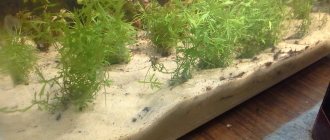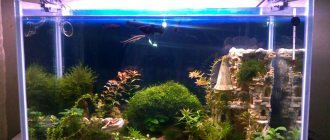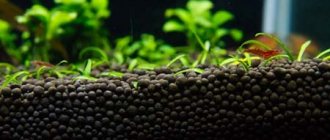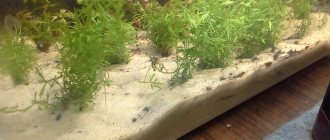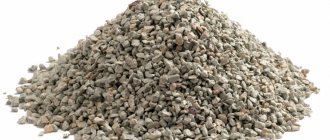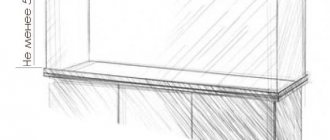According to scientists, fish are the very first inhabitants of our planet. Thanks to their adaptability to existence in water, they were able to survive all major and minor disasters on earth. People are interested in fish for two reasons - gastronomic And aesthetic. From the gastronomic side, everything is clear: caught and eaten. But the aesthetic side continued its development in the form of the creation of home aquariums. Every year the popularity of such aquatic systems increases, and people’s imagination in designing the internal space of a reservoir has no limits.
To fill the aquarium, fish of all kinds, plants, stones, various decorative elements, as well as the base - soil, consisting of different materials - stones, small gravel, expanded clay, sand are used. This article will discuss the type of ground laying for an aquarium, such as quartz sand.
What is quartz sand
Quartz is a fairly common natural white mineral mined from the earth's crust. After the procedure of extraction from the ground and washing, it is broken down into fractions of various sizes - from small 0.1 mm to large ones - over 5 mm .
Quartz sand differs from ordinary sand in its homogeneity of composition, better susceptibility to dirt, more pleasant appearance and other positive characteristics, which will be described below.
Features and Functions
Sandy substrate is widely used in aquariums due to its ease of care and availability. The simplest creatures found their habitat in it. The advantages of sandy soil include the following characteristics:
- good survival rate of aquarium plants;
- normal growth of green spaces;
- ease of cleaning the sandy bottom;
- fulfillment of all assigned biological tasks;
- an ideal option for a mass of bottom-dwelling creatures that cannot imagine their life without digging a light substrate;
- natural and attractive appearance.
Aquarium sand has not only advantages, but also some disadvantages:
- to rinse and prepare, you need to carry out more than one labor-intensive procedure;
- This type of soil requires special care, otherwise debris may accumulate;
- some types of sand can change the chemical composition of water;
- This type of substrate contains a small amount of nutritional components, which are not always enough for plant growth, so you will need to fertilize from time to time.
Color and size of quartz sand
This sand comes in several sizes - dusty - 0.1 mm , fine-grained - 0.25 mm , medium-grained - up to 0.5 mm , and coarse-grained - 3 mm .
The color ranges from pure white to black, which is considered rare and therefore the most expensive type of quartz sand. Its other name is morion . It contains aluminum impurities and looks very impressive in an aquarium.
When choosing the color of quartz, it is necessary to take into account the color of the fish - the lighter and more transparent they are, the darker the soil should be. You can also use painted sand, but you should make sure that the painting is done with high quality and will not harm underwater inhabitants and plants.
Types and their differences
If the choice is sand as a substrate for an aquarium, you should decide on its varieties - which one is better suited for the specifically conceived conditions and inhabitants. Correctly selected sand will look organically in the “interior” of the reservoir and create a comfortable environment.
Quartz
It comes in white and colored. The first is obtained from white crushed quartz. This soil creates a neutral environment without adding chemical elements from its composition to the water. In some cases, it can play a healing role, namely, neutralize iron and copper oxide, as well as manganese, which tend to form in aquariums. Color is obtained by tinting white quartz grains. This type is often used to decorate creative aquariums, where they want to create an unusual “interior”.
River
This type is used most widely due to its availability . Many people simply dig up the required amount on the river bank and sift it so that no small debris gets into the aquarium. You can also easily buy river sand at a pet store. Experts consider it useful for algae and glass reservoir inhabitants.
IMPORTANT! My advice is to use sand from shallows where there is less clay. Otherwise it will take a long time to wash it out.
Nautical
This variety is great for marine aquariums. This substrate will last a long time and will be convenient for plants and fish. Typically, sea sand contains many microscopic organisms that help balance the water. For this they call him “alive.” Extraction is carried out in the coastal zone, it cannot be dried - such soil is delivered wet to aquarium owners.
IMPORTANT! You need to make sure that the sea sand is properly and well washed and free of excess salt. Otherwise, it can ruin the entire ecosystem.
Black
It consists of magnetite, hematite and ilmenite - completely harmless heavy rocks. It does not release any additional substances into the water. Aquarists love it for its ability to create a black background against which brightly colored fish look gorgeous.
White aragonite
This is a fine crumb of crushed white coral. It contains a lot of calcium , which can increase water hardness. This soil is well suited for marine aquariums, but will harm fish that prefer a soft environment.
Advantages of using quartz soil
- Pleasant appearance and rich color palette.
- Does not release methane and ammonia into the water, as happens when using river sand.
- Produces carbon dioxide necessary for the respiration of fish and plants.
- Quartz soil does not sour and remains clean and fresh for a long period of time.
- Plant roots are well retained in such soil.
- Sand is neutral to various water compositions.
- Good circulation of water between quartz particles is ensured.
- Sand does not change the chemical composition of water.
- Real quartz does not absorb heat well, so the aquarium will always have a comfortable, cool temperature.
- Black quartz, which contains magnetite particles, does not color the water and, against the background of light-colored fish and plants, provides a special aesthetic pleasure with its spectacular decor.
Sand soil preparation
Before laying soil in the aquarium, it is necessary to take care of the safety of the future substrate, especially if soil obtained from the wild is used. Properly processed and harmless soil is obtained by washing and calcination, so it will be useful for every aquarist to learn how to clean the substrate.
First, the future aquarium filler is thoroughly washed: the sand is placed in small portions in a deep container and washed under running water, vigorously mixing the sand grains. The procedure is repeated until the liquid in the container is completely transparent.
After washing, the second stage of soil cleaning follows. Some owners try to kill harmful bacteria using chemicals, thereby making a huge mistake. The fact is that over time, sand treated with chemicals will begin to release toxic elements into the aquarium liquid, which will ultimately lead to the death of fish and plants. Instead of treating with chemicals, experts recommend boiling and calcining the sand in an oven.
To destroy harmful bacteria and protect aquarium inhabitants, owners of artificial reservoirs need to take the following actions:
- Boiling – the sandy soil is boiled for 15–20 minutes, continuously stirring the contents of the pan.
- Calcination in the oven - the sand is evenly distributed on a baking sheet in a thin layer, and placed in the oven for half an hour, setting the temperature to 100C.
The prepared filler is placed in an artificial reservoir, covered with a layer 3–5 cm thick.
Sand type of soil for an aquarium is one of the most popular and widespread options because it is easy to care for and clean, and besides, sandy soil in an artificial pond looks natural and helps to establish the biological balance in the aquarium.
Disadvantages of using quartz soil
- Sand contains small fractions that can cloud the water and cause sediment.
- This sand is not recommended for use in aquariums with fish that burrow into the ground - eels, stingrays, since the sharp edges of the fractions can injure them.
- Sand contains insufficient minerals for underwater plants, so additional feeding is necessary for their growth.
- Quartz sand is very easy to counterfeit, passing off the technical grade as genuine. Therefore, when purchasing such sand, you need to be very careful so as not to become a victim of unscrupulous sellers. How not to make a mistake in choosing quartz soil will be discussed in the next paragraph.
Which one is better to fall asleep?
Choosing sand for an aquarium even at the stage of purchasing or preparing it yourself requires attention. Final preference should be given based on the characteristics of the fauna that is planned to be added to the aquarium.
General rules:
- The grains of sand are approximately the same size – 1.5-2 mm. Smaller fractions are not suitable, since in such soil the aeration process does not work well, microorganisms begin to multiply, and stagnation begins. The aquarium will quickly become dirty. The inhabitants will begin to suffer. From larger ones, including pebbles, the organic matter on which plants live is quickly washed away.
- It is better to focus on natural colors . Experts say that some dyes, for example, pink or yellow, for all their aesthetic appeal, can release substances harmful to the inhabitants into the water.
- The thickness of the layer in the aquarium is approximately 4 cm to 6 cm.
- When harvesting yourself, you should collect the substrate in a clean reservoir. You should check it to make sure there are no glass shards, pebbles or debris. In addition, natural sand must be thoroughly rinsed under running tap water.
IMPORTANT! If you pay all your attention only to the aesthetic component, then you should not expect a good and long-term result. Sand is an important element in the ecosystem of a small glass reservoir, so its physical and chemical characteristics cannot be neglected.
But it is better not to use construction sand due to possible harmful impurities.
How to check the authenticity of quartz sand
When buying quartz sand for an aquarium, you need to be extremely careful not to buy a craft product. The authenticity of the sand is indicated by the following signs:
- When reacting with acetic acid, there are no bubbles, and the color of the sand does not change.
- Real sand must have natural defects - cracks, degrees of transparency.
- Uneven sand color. If the color looks even and monochromatic, then most likely it is a fake - technical or other crushed type of sand, colored with various chemicals.
- When sand particles rub against glass, scratches appear on it.
Video about choosing sand for an aquarium
Author of articles, expert. I have been involved in aquariums since childhood. I have extensive experience in keeping and breeding aquarium animals and plants. I read a lot on the topic of aquarium husbandry to improve my knowledge.
The presence of sand in the soil is a mandatory condition for an aquarium, because in the natural aquatic environment there are rarely any grains of sand at the bottom of a reservoir. In addition, it is a highly hygienic material that does not introduce pollution and even helps purify water. It is a decoration for a mini-reservoir.
But more important is the role of coarse powder as a habitat for beneficial microorganisms and aquarium flora. Over time, this biological environment becomes both a recycler of waste from the inhabitants and a supplier of nutrients to plants. To a large extent, the choice in favor of soil of one size or another is influenced by the size of the aquarium inhabitants themselves. This is a whole ecosystem in miniature, but with the same real processes as in normal reservoirs.
How to choose the right quartz sand
- For small fish you need to choose fine sand fractions . They like to hide in the soil and eat its particles, and therefore the most comfortable size of soil fractions for underwater “excavations” would be 0.25 mm .
- Larger fish require sand containing larger constituent elements. Large individuals prefer to hide not in the sand, but in thickets of underwater greenery, and fine sand can get into the gills and cause various diseases. Therefore, a fraction size of 3-5 mm will be the most optimal option for them.
- Underwater plants feel better in sand with coarse fractions, as they promote better water circulation and washing of the roots.
Aquarium cleaning
No matter how wonderful filters you equip your aquarium with, the soil must be cleaned periodically.
There are reviews that cleaning the sandy bottom is extremely problematic. But everything is not so scary, and cleaning the aquarium with your own hands is not difficult. The soil surface must be siphoned regularly. This is done using a special device - an aquarium siphon, which can be purchased at pet stores.
The siphon is designed like a vacuum cleaner: it draws out water along with dirt particles. In this case, the grains of sand are not retracted, but return to their place. In addition to the siphon, you will need a bucket into which the water will be drained. If the aquarium is large (from 100 liters), it is better to purchase a long hose and run it directly into the bathroom and toilet - for convenience.
How to siphon sandy soil correctly:
- Before cleaning, prepare settled water.
- Press the siphon cylinder to the ground. Some devices have a bulb that can be used to create traction. If it is not there, you need to blow into the hose.
- Carefully go all the way to the bottom of the aquarium. Make sure that not a lot of water is lost: you need to clean the soil so as to replace no more than 20-25%.
- After cleaning is complete, add new water to the aquarium.
Please note that you do not need to siphon the soil near the roots of the plants. Firstly, this is a nutritious feed for them, and secondly, the roots can be easily damaged by the siphon.
Beginning aquarists may think that they need to siphon the soil every week after introducing fish into a new aquarium. But in reality it is better to wait a little and let the medium form in the sand. There is no need to replant the fish during cleaning, so you should siphon the soil with great care. If you are not careful, some particularly restless fish can get caught in the siphon - keep an eye on your pets!
When choosing a siphon, pay attention to the diameter of the hose. The larger the diameter, the stronger the water pressure. Accordingly, for small aquariums you should not use a large hose - you will simply drain all the water before cleaning the bottom. If the water pressure is too strong, you can reduce the diameter of the hose with your own hands: just squeeze it slightly.
It is necessary to siphon sandy soil at intervals of 2-4 weeks. The period depends on the number of fish in the aquarium. Once every few years (from 1.5 to 3), the substrate is completely removed from the aquarium to be washed.
Aquarium sand is invaluable if you want to create the most natural environment for your fish and plants. Despite the apparent difficulties associated with processing and cleaning, sand has a number of distinctive properties that make it one of the best substrates for aquariums.
Return to content
How to lay soil
After preparing the soil in the oven, you can put it in the aquarium. To begin with, you should evenly place peat on the bottom of the aquarium. It is necessary for the successful functioning of the ecosystem in your underwater world. Next, we pour it into an empty aquarium. The easiest way to do this is with a light plastic spatula, so as not to break the glass walls of the tank.
If the sand contains decorative pebbles, lower the spatula to the very bottom to avoid damage. The sand should not be poured evenly. It is better to try to replicate the contours of the natural water bottom. For this you can use various pebbles. The soil can reach different heights. Typically its height varies from 2 to 8 cm
Selection criteria
If you have already decided on the choice of soil, then you should know how to choose the safest and most convenient aquarium sand in the store or simply in the environment.
- Choose it depending on the characteristics of the underwater fauna. If fish live in hard water, then it is worth taking one that does not affect water hardness and vice versa.
- Its particles should be approximately the same. Otherwise, it will quickly turn to stone and toxic substances will accumulate in it.
- It is worth using a substance with sand grains of at least 1.5 mm in diameter. With a smaller size, the sand will not be able to perform its oxygen exchange functions and the tank will quickly become dirty.
- It is better to take natural colors, since bright colors of the soil, such as yellow or pink, can form harmful substances, although they look very impressive
- If you don’t want to spend money buying sand at a pet store, you can find it in a natural body of water. However, the pond must be clean and the sand must not be contaminated with toxic substances. Review it carefully. It should not contain glass shards, stones or other debris. Don't forget to learn how to rinse sand.

